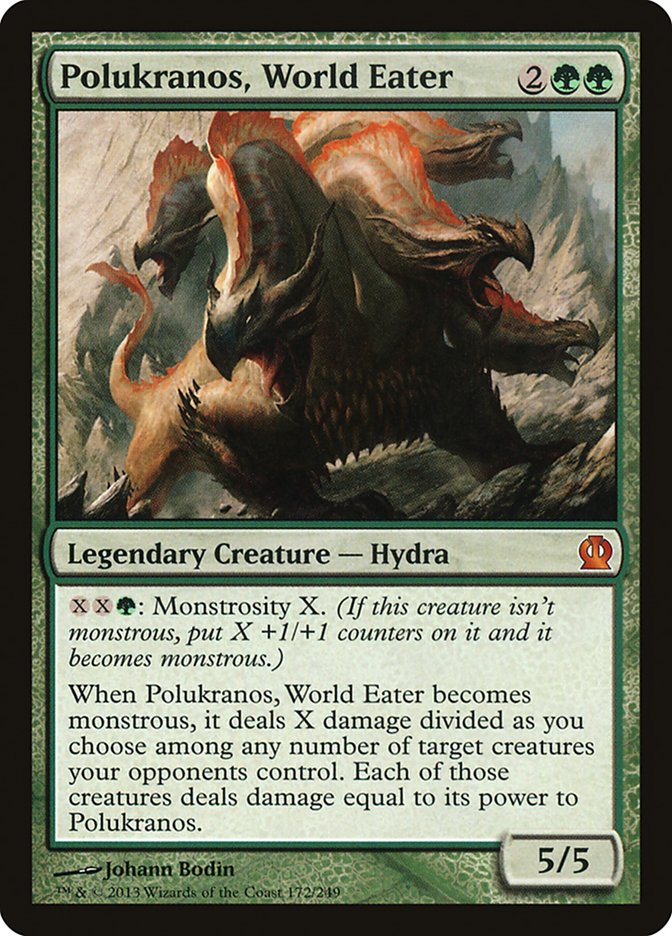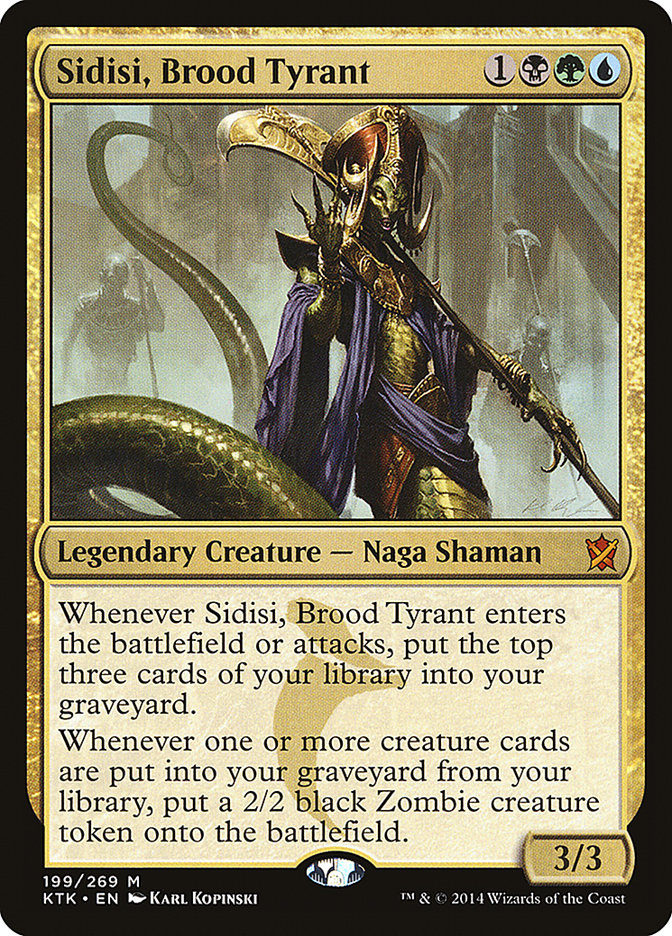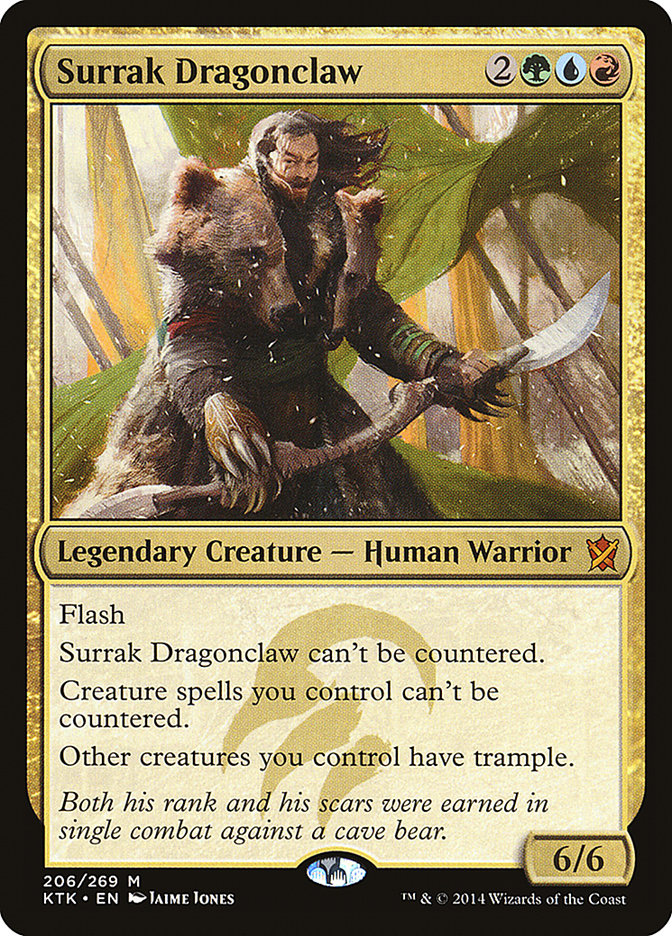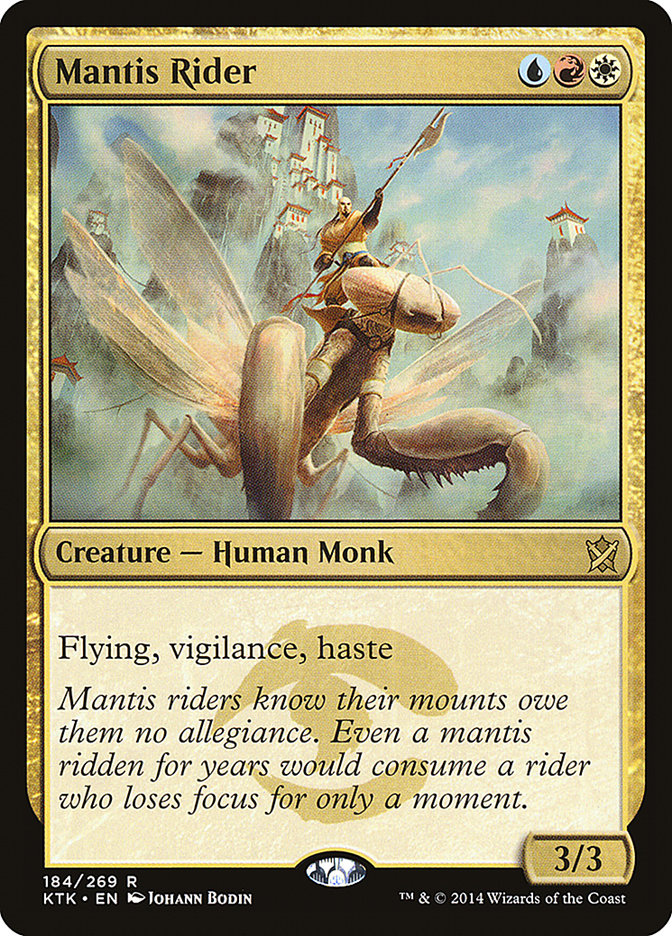Khans of Tarkir has almost invaded this ever stale Standard format. Just one more weekend of playing against Mono-Black Devotion and we will all feel the
Moving forward with a set rotation always starts with these three questions:

sweet relief of multicolored goodness! At least that’s what everyone is saying. Will Standard be filled with three color decks running rampant? Will Khans
of Tarkir hold up to the hype and be able to break down the walls of Theros block? That’s exactly what we are going to find out today!
How good are the aggressive decks?
How good are the control cards?
How good is the mana?
Doesn’t it just always come down to the mana? The thing about manabases is that they are only as good as what you can get away with. If the aggressive
decks are slow and two colors, then you can play three colors and all the juicy tap lands that come with them. If the aggressive decks are fast and
mono-colored, you might have to only indulge in two colors worth of spells.
Good aggressive decks tend to force the non-aggressive decks into only playing two colors. Not only can you not get away with three color mana bases due to
how punishing they can be, but there really isn’t a need to have extremely powerful cards to get the job done against these early aggressors.
Things change if the control decks are also good. If control decks can function in the format, then three colors becomes essential to have enough tools to
appropriately fight the matchup. Two color decks sometimes don’t have enough anti-control cards to compete against attrition based strategies.
So what do we have for aggressive decks?
Creatures (24)
- 4 Foundry Street Denizen
- 4 Akroan Crusader
- 4 Firedrinker Satyr
- 4 Mogis's Warhound
- 4 Goblin Rabblemaster
- 4 War-Name Aspirant
Lands (20)
- 20 Mountain
Spells (16)

Creatures (18)
Planeswalkers (3)
Lands (23)
Spells (12)

Add 4 Grim Haruspex (2B, 3/2, When a nontoken creature you control dies, draw a card. Morph B) and there you go!
Todd’s Rabble Red deck was amazing in our Versus Video that you guys will see next week. It had the speed of Boss Sligh with the resiliency of Rabble Red.
This deck is no joke since the two most powerful cards in Rabble Red didn’t rotate – Goblin Rabblemaster and Stoke the Flames.
The B/W Aggro deck might not be a real thing, but it sure could be with enough work. This list is as rough as it can be, and I will put more work on it
when it becomes more relevant, but I just wanted you to see the general idea of the speed of the format. This deck has all the speed of Mono-Black Aggro
from Theros block Constructed but with the added bonus of Sorin, Solemn Visitor being absolutely what the deck needed. Not only does this planeswalker
boost the team for combat, but it also creates evasive threats. Since it starts with four loyalty, you will be able to tick it down twice when you flood
out on them to be able to use the additional copies. His loyalty numbers clearly were not by mistake, and he was meant to have additional copies be
playable.
So what about control decks?
The only saving grace for control decks is the insane power of Elspeth, Sun’s Champion. There really isn’t a great card advantage spell lined up for the
archetype and any way to remove creatures en masse costs five mana. Aetherspouts and End Hostilities may see some play, but my gut tells me that control
isn’t going to be as good as it was in the past. We will see, of course, but my money is on aggro and midrange strategies ruling for the first couple of
weeks.
The absence of control could very well force midrange decks to carry the weight of controlling the aggressive decks. We might see an uptick in Anger of the
Gods since midrange decks won’t get punished by control decks for playing cards like that. This might also be the way midrange decks can afford playing so
many colors.
Speaking of colors, now we finally get to talking about mana! Let’s see what we’re working with.
First off, we have all ten Temples at our disposal. After that we have the five tri-lands to complement our coming into play tapped theme. Lastly we have
ally fetchlands and enemy painlands. What this means is that there are a ton of dual lands available, but they all come at a slight cost (either time or
life). Each two color deck will have access to at least eight dual lands, and every three color deck will have access to more dual lands then they know
what to do with.
So what does this all mean?
Well even though we have a ton of mana fixing, it all deals us damage or comes into play tapped which can cause us to take more damage against the
aggressive decks. That isn’t really all that good if you think about it. Each three color combination will have access to more dual lands then any deck
wants to play, but that does not mean the mana will be good. Three color decks will have issues casting spells at the correct time and not falling behind
on life and tempo when setting up. This has and will always be the case.
The trick is finding the payoff spells to make it all worth it, but thankfully Khans of Tarkir has those in spades. The reason for the creatures being
pushed so heavily in Khans of Tarkir is due to non-other than the World Eater itself.
Find me a four drop in Khans of Tarkir that will be better than this thing, and I will pie myself
! I should probably elaborate before people start listing off every four drop in the set. Polukranos isn’t the end all be all Magic card, but it is bigger
than every other four drop, so on stats alone it is king. It also only costs green mana, so a mono colored green deck can easily have the biggest creature
on the field.
I don’t think WOTC wants to start making creatures bigger than Polukranos at four mana without adding a significant downside, and who wants sweet
multicolored cards with downsides? Isn’t being three colors already a negative? 5/5 is as big as it is going to get which means that the new cards will
have to be pretty good to compete with the already available Elvish Mystic, Courser of Kruphix, Sylvan Caryatid, Polukranos, World Eater shell we will soon
have to work with.
This set looks to be breaking the mold of not wanting to play three colors due to inconsistent manabases simply because the cards are absurdly powerful.
Just looking at the set shows that WOTC is not messing around. They want Khans of Tarkir to be popular, and I can’t really argue with the execution. These
cards are fantastic!
Now looking into the wedges that Khans of Tarkir provide opens up a ton of possibilities. Many of the three-colored cards have been pushed to be far more
powerful than any other set prior. This is because Khans of Trakir is a wedge based set and WOTC wants us to play with those cards. It’s also this way
because Theros was absolutely broken in power level, and they needed the cards to compete. And finally, the new way cards will rotate will leave this set not dominating for two whole years like Sphinx’s Revelation just did.
Cards are getting better ladies and gentlemen ,so get ready for some haymakers! Let’s start with my favorite card in the set and see what we can do with
it!
This card is so pushed that it almost fell down and bruised its knee! Seriously, I have never seen a card that can simply take over a game on its own but
also has so much backup to make it an absolute beating in Constructed. The whole set isn’t even out yet, but this deck looks busted using the enablers from
just Theros Block.
Creatures (27)
- 3 Hornet Queen
- 4 Elvish Mystic
- 4 Sylvan Caryatid
- 4 Satyr Wayfinder
- 4 Nyx Weaver
- 2 Soul of Innistrad
- 2 Necropolis Fiend
- 4 Sidisi, Brood Tyrant
Lands (23)
Spells (10)

I love the look and feel of this deck. We might only be splashing for a single blue card in the main, but that doesn’t mean it isn’t worth it. My guess is,
like always, the enablers will be the last cards spoiled so we can finally know how we are supposed to play with all of these amazing cards. Even now
though I think this deck looks amazing!
Next on the “How could they print that?!” list we have Surrak Dragonclaw.
This wedge lord had to have been pushed further and further until it was apparent that they wanted Temur to be a dominant force in Standard. Not only does
this card have an amazing body for casting cost, but his abilities are all extremely powerful. Let’s take a look at what a Temur deck might look like.
Creatures (24)
- 4 Elvish Mystic
- 4 Polukranos, World Eater
- 2 Sylvan Caryatid
- 4 Goblin Rabblemaster
- 4 Rattleclaw Mystic
- 4 Savage Knuckleblade
- 2 Surrak Dragonclaw
Planeswalkers (3)
Lands (25)
Spells (8)
Sideboard

Temur is the aggressive wedge. The removal in the colors isn’t good enough to dispatch the strongest of foes so tempo is going to be the key resource this
deck is going to have to utilize. It’s a good thing the entire wedge has the most powerful creatures in all the land. This wedge is all about power and
speed, and this decklist showcases it all.
There might be a certain satyr that is missing from this deck. You know, that one who likes to revel. Well Xenagos, the Reveler has seen better days, and
I’m pretty sure that his best were behind him due to a stupid insect riding monk.
This leaner and quite meaner Lightning Angel is the real deal! I would not have said this earlier this week before Todd beat the crap out my Xenagos with
it. Not only does this card come down as early as turn 3, but it packs a very strong punch. Paired alongside Sarkhan, the Dragonspeaker, Mantis Rider might
just be the next Restoration Angel. Not in the “surprise’ kind of way, but in the “creating an entire archetype around it” way. You know, because it is that good.
I don’t have a list quite yet for Jeskai simply because this archetype needs the whole set to be revealed before even knowing how to build with it. It will
depend on what the other decks can do before we start developing a strategy for this archetype since it can try to do so many things. Time will tell, but I
can assure you that Mantis Rider will be a tier one Magic card.
Next on my list is Abzan, the wedge based around +1/+1 counters. This clans’ whole shtick is to create everlasting life with Abzan Ascendancy, lifegain
with Siege Rhino, and pretty much the gameplan Brian Braun-Duin is always trying to execute. However, I don’t actually care about any of that because what
excites me the most about this wedge is using the cards that were too weak for Standard from Theros Block.
I want to get my constellation on!
Creatures (22)
- 4 Elvish Mystic
- 4 Sylvan Caryatid
- 4 Courser of Kruphix
- 4 Eidolon of Blossoms
- 3 Doomwake Giant
- 3 Brain Maggot
Planeswalkers (2)
Lands (23)
Spells (13)

Constellation was actually extremely powerful in Standard except for the fact that it couldn’t compete with a Sphinx’s Revelation deck. This and only this
was the reason that this strategy was pushed out of Standard, which makes it a great candidate to break out once Revelation is no longer with us. This is
the strategy I will be most interested in for the first couple weeks of the format. Not only does this deck have card advantage against the other midrange
decks, but great removal for the formats’ best threats, and punishing threats like Doomwake Giant and Courser of Kruphix against the Rabble Red decks. It
really is the full package as long as dedicated control isn’t a real thing.
All in all, I think the power level of the new cards along with the defensive capabilities of the green early game will make playing three colors fairly
easy. I think it’s time for us to strap in for one of the most haymaker Standard formats we have seen in a while. Things are about to get wild!
By this time next week, we will have the entire spoiler which will make my job a whole lot easier! No more guessing and much more trying to break the
format for the double Open Series Release Weekend!




